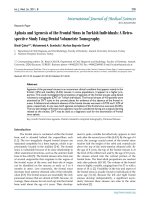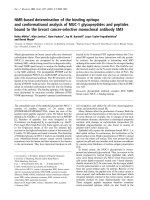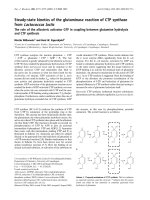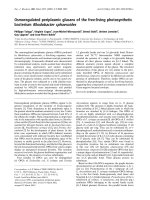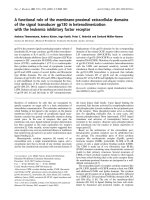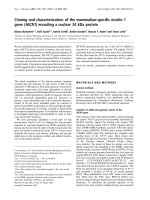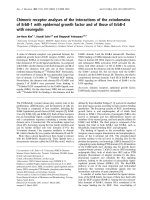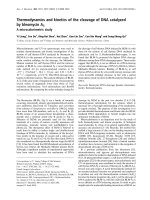Báo cáo y học: "Spindle Cell Lipoma of the Hypopharynx"
Bạn đang xem bản rút gọn của tài liệu. Xem và tải ngay bản đầy đủ của tài liệu tại đây (493.29 KB, 3 trang )
Int. J. Med. Sci. 2011, 8
479
I
I
n
n
t
t
e
e
r
r
n
n
a
a
t
t
i
i
o
o
n
n
a
a
l
l
J
J
o
o
u
u
r
r
n
n
a
a
l
l
o
o
f
f
M
M
e
e
d
d
i
i
c
c
a
a
l
l
S
S
c
c
i
i
e
e
n
n
c
c
e
e
s
s
2011; 8(6):479-481
Case Report
Spindle Cell Lipoma of the Hypopharynx
Muhammed Fatih Evcimik
1
, Fazil Emre Ozkurt
2
, Tarik Sapci
3
, Ziya Bozkurt
2
1. Istanbul Nisa Hospital Department of Otorhinolaryngology-Head & Neck Surgery, Istanbul, Turkey
2. Fatih Sultan Mehmet Training & Research Hospital, Department of Otorhinolaryngology-Head & Neck Surgery, Istan-
bul, Turkey
3. Istanbul Bilim University, Medical Faculty, Department of Otorhinolaryngology-Head & Neck Surgery, Istanbul, Turkey
Corresponding author: Muhammed Fatih Evcimik, MD, Address: Istanbul Nisa Hospital, Fatih Cad. No:1 Yenibosna,
Bahcelievler İstanbul, Turkey. E-mail: ; Phone: +90 5057763567; Fax: +90 2125714564
© Ivyspring International Publisher. This is an open-access article distributed under the terms of the Creative Commons License (
licenses/by-nc-nd/3.0/). Reproduction is permitted for personal, noncommercial use, provided that the article is in whole, unmodified, and properly cited.
Received: 2010.11.24; Accepted: 2011.07.25; Published: 2011.08.06
Abstract
Objective: We report a rare case of a spindle cell lipoma with atypical clinical course.
Case report: A 51 year old female patient referred to our clinic with feeling of mass in the
throat she had had for two years. The patient described difficulty in swallowing. Indirect
laryngoscopy did not reveal any masses at bilateral pyriform sinuses, and the mucosa
had a natural appearance. However, a mass with a stalk was detected in the side of the
mouth when the patient retched. Endoscopic monitoring of the mass revealed its origin
to be the left sinus pyriformis. No pathological structures could be detected in the indi-
rect laryngoscopy taken after the patient gulped again. The mass was shown by magnetic
resonance imaging to extend into the esophagus. It was removed using suspension mi-
crolaryngoscopy. Postoperative control revealed a complete healing at the excision site.
Immunohistochemical examination for pathological diagnosis indicated a spindle cell
lipoma.
Conclusions: Laryngeal and hypopharyngeal lipomas are rare forms of benign laryngeal
neoplasms. Their asymptomatic course makes diagnosis difficult. The patient is pre-
sented here with related clinical and pathological features.
Key words: Dysphagia, Head and Neck, Adult, Diagnosis, Spindle Cell Lipoma, Hypopharyngeal
lipoma
Introduction
Lipomas are the most frequently observed soft
tissue tumors in adults. They commonly occur in the
neck and on the trunk, and are frequently located at
the subdermal, while rarely at the dermal tissue layer.
They are commonly found at the dorsal neck, nape,
shoulders, and the back
1
. Spindle cell lipoma was first
defined by Enzinger and Harley in 1975
2
. It is more
frequently found in men between the ages of 40–60,
and is a soft tissue tumor characterized by replace-
ment of the mature fat tissue by spindle cell prolifera-
tion
2,3
. Although they are mostly solitary,
well-capsulated, and slow-growing, they should be
pathologically differentiated from liposarcomas.
Case Report
A 52-year-old female patient referred to our
clinic with feeling of thickness in the throat, and a
mass in the mouth while coughing. She described her
complications as having begun 5 or 6 years previous-
ly, with a mass appearing in her mouth every time she
retched in the last two years. The patient described no
occurrence of dysphagia during this period. Her ex-
amination revealed a normal oral cavity and oro-
Ivyspring
International Publisher
Int. J. Med. Sci. 2011, 8
480
pharynx. Tongue root, vallecula, sinus pyriformis,
epiglottis, ventricular folds, and the vocal cords had a
normal appearance upon endoscopic examination.
However, it was observed that the mass projected up
to her teeth when she retched (Figure 1). After the
mass was stabilized, endoscopic monitoring revealed
it to be smooth surfaced and its origin to be left sinus
pyriformis. Preoperative magnetic resonance imaging
of the patient revealed a polypoid structure approxi-
mately 6 cm long and 5 mm in diameter, correspond-
ing to the laryngeal vestibule level in sagittal section,
projecting towards the inferior from the arytenoid
cartilage level. It appeared hypointense in
T1-weighted sequences, and hyperintense in
T2-weighted sequences. Contrast was positive fol-
lowing intravenous contrast administration (Figure
2). The mass was removed surgically by suspension
microlaryngoscopy. The resected mass was observed
to be yellowish in color; smooth-surfaced, solitary,
and well-capsulated (Figure 3). Pathological exami-
nation of microscopic sections revealed a multilobular
mass, with spindle and star-shaped cells lacking
well-defined borders located beneath the squamous
epithelium in the myxoid area. No mitosis was ob-
served, while rare giant cells were detected (Figure 4).
Angiomyxolipoma was considered initially, yet im-
munohistochemical analysis was requested for elim-
ination of possible aggressive angiomyxoma and least
likely low grade liposarcoma. The immunohisto-
chemical examination revealed diffused immunoex-
pressions of CD34 and Vimentin. It was negative for
CDK4, S-100 and MDM2. No immune expression was
detected in the other panels studied. The diagnosis
was confirmed as myxoid type spindle cell lipoma.
The excision region was monitored as normal at
postoperative month 6. The patient was asympto-
matic.
Figure 1. Preoperative view.
Figure 2. Preoperative magnetic resonance imaging (Sag-
ittal section).
Figure 3. Hypopharengeal mass (Intraoperative view).
Figure 4. Histological section of the spindle cell lipoma
within collagenous stroma (Hematoxylin and Eosin X40).
Int. J. Med. Sci. 2011, 8
481
Discussion
Lipomas are mesenchymal benign lesions origi-
nating from the mature lipid tissue
1
. They constitute
approximately 0.6% of the laryngeal and hypopha-
ryngeal benign tumors
4
. Laryngeal and hypopharyn-
geal lipomas first appeared in literature in 1995
5
.
Laryngeal lipomas originate from adipose tissues
such as epiglottis, ventricular folds, and aryepiglottic
fold. No cases with laryngeal lipoma at vocal cords
have been reported. Hypopharyngeal lipomas origi-
nating from pyriform sinus have similar symptoms
and pathological features with laryngeal lipogenic
tumors
5
. Laryngeal or hypopharyngeal lipomas are
well-capsulated, smooth-surfaced, yellowish, sessile
or pedicled masses. They contain histologically ma-
ture, uniform adipose cells. Spindle cell lipomas con-
tain collagen fibers and small, cylindiric spindle cells
and mixed mature adipocytes within a matrix con-
taining mucinous material. Spindle cell lipomas ap-
pear 60 times less frequently compared to the classical
lipomas
2
. Described for the first time by Enzinger and
Harvey in 1975, this benign tumor is characterized by
replacement at varying degrees, of the mature adipose
tissue by proliferation of collagen producing spindle
cells
3,5,6
. While the two components usually appear at
equal proportions, there are lesions where one com-
ponent appears dominant. Differential diagnosis may
be difficult in especially cases where spindle cells are
dominant. Spindle cells appear as uniform cells with
single elongated nucleus, and narrow bipolar cyto-
plasm in SCL. Nucleolus is not prominent. Mitosis is
rare. Spindle cells form short parallel clusters
3,7
. Mis-
diagnosis is possible, as the histological characteristics
of SCL are similar to those of liposarcoma
2,8
; howev-
er, uniformity of the spindle cells, lack of lipoblasts,
and presence of thick mature collagen fibers are typi-
cal features of SCL
2
. Immunohistochemically, spindle
cells express CD34, bcl-2, and vimentin, but not S-100.
Recently, MDM2 and CDK4, well-known key regula-
tors of cell cycle progression, were found to be ex-
pressed in liposarcomas. They are never expressed in
lipomas and normal mature adipocytes. Typical ap-
pearance of lipogenic tumors in the larynx and hy-
popharynx are as submucosal yellowish or polypoid
masses. Adipose tissue is characterized by a less den-
sitometric appearance compared to water at comput-
erized tomography and magnetic resonance imaging
9
.
SCL is generally solitary and slow-growing, and be-
comes symptomatic at advanced stages of life. It usu-
ally causes swallowing impairment, phonation prob-
lems, the sensation of a lump in the throat, and rarely
respiratory problems due to glottic obstructions. Di-
agnosis is often difficult due to indistinct symptoms
5,7
.
In this case, the feeling of a mass in the throat without
dysphagia was the only symptom of large pyriform
sinus lipoma. The preferred method of treatment for
laryngeal and hypopharyngeal lipogenic tumors is
radical endoscopic excision.
Summary
Laryngeal and hypopharyngeal lipomas are rare
forms of benign laryngeal neoplasms. Their asymp-
tomatic course makes diagnosis difficult. In this case,
feeling of a mass in the throat without dysphagia was
the only symptom of large pyriform sinus lipoma.
Although the mass may be asymptomatic, it should be
surgically removed, and undergo a detailed histo-
pathological and immunohistochemical examination
for diagnostical purposes.
Conflict of Interest
The authors have declared that no conflict of in-
terest exists.
References
1. Rydholm A, Berg NO. Size, site and clinical incidence of lipo-
ma. Factors in the differential diagnosis of lipoma and sarcoma.
Acta Orthop Scand 1983; 54: 929-934.
2. Erzinger FM, Harvey DA. Spindle cell lipoma. Cancer 1975; 36:
1853-1859.
3. Weiss SW, Goldblum JR. Benign lipomatous tumors. In: Weiss
SW, Goldblum JR, eds. Enzinger and Weiss’s Soft Tissue Tu-
mors; 4th ed. St Louis: Mosby. 2001: 571–639.
4. Jones SR, Myers EN, Barnes L. Benign neoplasms of the larynx.
Otolaryngol Clin North Am 1984; 17: 151-178.
5. Wenig BM. Lipomas of the larynx and hypopharynx: a review
of the literature with the additional of three cases. J Laryngol
Otol 1995; 109: 353-357.
6. Persaud RAP, Kotnis R, Ong CC, Bowdler DA. A rare case of a
pedunculated lipoma in the pharynx. Emerg Med J 2002;19:275
7. Fletcher CD, Martin-Bates E. Spindle cell lipoma: A clinico-
pathological study with some original observations. Histo-
pathology 1987; 11: 803-817.
8. Wenig BM, Weiss SW, Gnepp DR. Laryngeal and hypopha-
ryngeal liposarcoma. A clinicopathologic study of 10 cases with
a comparison to soft-tissue counterparts. Am J Surg Pathol
1990; 14: 134-141.
9. Remacle M, Mazy G, Marbaix E, Dooms G, Hamoir M, Van den
Eeckhaut J. Contribution by tomodensitometry to the under-
standing and diagnosis of benign non-epithelial endolaryngeal
tumours. In connection with a case of chondroma, one of lipo-
ma and one of rhabdomyoma. Acta Otorhinolaryngol Belg
1983; 37: 820-829.

